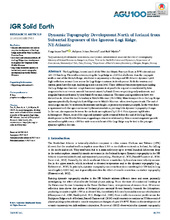| dc.contributor.author | Tan, Pingchuan | |
| dc.contributor.author | Breivik, Asbjørn Johan | |
| dc.contributor.author | Mjelde, Rolf | |
| dc.date.accessioned | 2020-06-19T12:30:44Z | |
| dc.date.available | 2020-06-19T12:30:44Z | |
| dc.date.issued | 2019 | |
| dc.Published | Tan P, Breivik AJ, Mjelde R. Dynamic Topography Development North of Iceland from Subaerial Exposure of the Igneous Logi Ridge, NE Atlantic. Journal of Geophysical Research (JGR): Solid Earth. 2019;124:10799-10822 | eng |
| dc.identifier.issn | 2169-9356 | en_US |
| dc.identifier.issn | 2169-9313 | en_US |
| dc.identifier.uri | https://hdl.handle.net/1956/22771 | |
| dc.description.abstract | The Logi Ridge, located north of the West Jan Mayen Fracture Zone, is E-W oriented and 140-150 km long. The seafloor surrounding the Logi Ridge is ~0.65 km shallower than the conjugate seafloor east of the Mohn’s Ridge, attributed to asymmetry in the regional NE Atlantic dynamic uplift. Eight reflection seismic lines across the Logi Ridge constrain its development. Both the western and eastern parts have flat tops, indicating erosion at sea-level. Three different basement types surrounding the Logi Ridge are observed: rough basement represents abyssal hills original, or reactivated by later magmatic/tectonic events; smooth basement caused by basalt flows overprinting early sediments; irregular basement formed by later basalt flows and intrusions. The surrounding sediments have two distinct units, where the unit boundary is Middle Miocene (12-14 Ma). Mass transport from the Logi Ridge appears episodically throughout Late Oligocene to Middle Miocene, when development ends. The end of erosion age can also be estimated from seamount height, or present top seamount depth. In the west there is agreement with the age constrained by the sedimentation, proving little dynamic topography change. In the east, discrepancies between the methods are explained by 0.15-0.3 km dynamic uplift after submergence. Hence, most of the regional dynamic uplift occurred before the end of the Logi Ridge development in the Middle Miocene, suggesting a causative relationship. Minor recent magmatic growth and seafloor uplift over a ~100 km wide zone south-east of the Logi Ridge may be tied to the younger dynamic uplift in the east. | en_US |
| dc.language.iso | eng | eng |
| dc.publisher | AGU | en_US |
| dc.title | Dynamic Topography Development North of Iceland from Subaerial Exposure of the Igneous Logi Ridge, NE Atlantic | en_US |
| dc.type | Peer reviewed | |
| dc.type | Journal article | |
| dc.date.updated | 2020-01-29T09:23:10Z | |
| dc.description.version | publishedVersion | en_US |
| dc.rights.holder | Copyright American Geophysical Union. All Rights Reserved. | en_US |
| dc.identifier.doi | https://doi.org/10.1029/2019jb017603 | |
| dc.identifier.cristin | 1779060 | |
| dc.source.journal | Journal of Geophysical Research (JGR): Solid Earth | |
